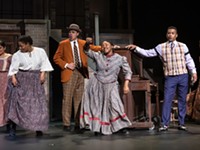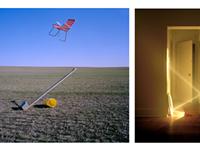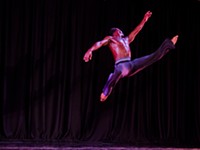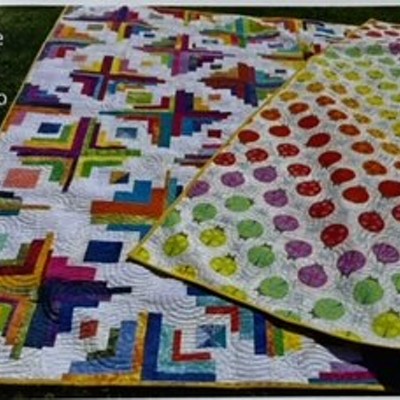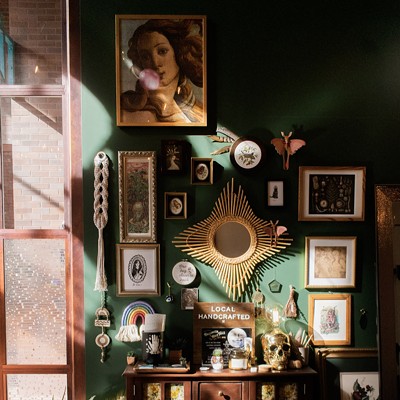[
{
"name": "500x250 Ad",
"insertPoint": "5",
"component": "15667920",
"parentWrapperClass": "",
"requiredCountToDisplay": "1"
}
]
"All of my work is about the search for spirituality," says Lorna Bieber in the cell phone tour that accompanies "Fabrications," an exhibit of her largescale, black and white work currently in the Project Gallery at Eastman Museum.
"To me, spirituality means trying to connect to the unseen forces that lie beneath the material world," she says. "Art seems like a perfect place to explore this, and in my art I hope to awaken a sense of the ineffable -- a place where we stand in awe, but don't feel diminished."
Encountering Bieber's work, the viewer is immersed and invited into realms of layered or disjointed natural imagery that suggest a narrative, but require the audience's participation in filling in the blanks.
"Storytelling has always been important to me," Bieber says. "There's always an implied narrative in my work, but I've never been interested in producing a straightforward linear story."
Bieber's "Houses" is a grid of 96 prints on paper, made of shots of barns, citadels, towers, and country homes that are each outlined with thick brushstrokes. The angled buildings are set again clouds, trees, and terrain, but it's disjointed from any smooth flow between one and the next.
Quilt-like and out of sequence, this patchwork of a region's structures forces the eye to skip across time and space to reconstruct what might be.
"I wanted to create ruptures, I wanted to disrupt our usual way of seeing," she says. "Each individual image is a fragment, a subplot to the entire piece. And as our eye leaps from picture to picture and section to section, our brain fills in gaps of time and perception."
Bieber's background is in painting, but she became interested in the photographic image as subject while working in the art department and then as a photo editor for large-circulation magazines in the late-1980's. For more than 20 years, she's developed methods of photocopying and manipulating stock images -- enlarging or reducing, drawing and painting over them, and often presenting them arranged into largescale grids.
Much of the work in this show takes nature as its subject, though Bieber's most recent efforts include figurative and allegorical elements.
Aside from the "Houses" installation, the gallery's first room holds five large gelatin silver prints. In one of the largest prints, "Sled," a dog strains in the snow to tow its titular burden, which is just emerging from off-shot as two tusk-like runners.
Nearby, in "Bush," three dogs race past some tall, scratchy brush, connected to one another by lines, their tongues lolling from the effort.
Bieber says her series on dogs was kick-started after she saw a PBS program about rescue working dogs that assist the handicapped. "These weren't cute pets; they hadn't been formed into frightening guard dogs," she says. "I wanted to capture their innate dignity."
This series marked a turning point in her work, she says. Up until this point, she'd felt that she needed to make her alterations of her source photos overtly visible, either by collaging or drawing on the photos.
"With the dogs, I finally understood that the alterations I made in my studio -- cropping the work and altering it on my copier, and the interventions in the darkroom creating a surface that moved in and out of focus, drastically changing the scale, changing the tonalities -- that these were sufficient," she says.
Bieber aims to make viewers feel that they might walk into the photo by playing with focus throughout each image. Blurred sections over parts of the rushing beasts and the snowbound environment suggest the eye trying to reconcile motion directly in front of it. All of this is playfully at odds with the stark, photocopied texture that collapses the scene once more.
The presence of this texture in the woodland image, "Path," suggests a jacquard weaving of a snowy, shadowy trail more than a photo collage. This is also the desired effect for Beiber's "Tapestry," a photo collage printed on canvas that fills the long wall of the gallery's inner room, and was debuted with the opening of this exhibit.
This work was inspired by a close encounter with the minutia in a corner of a massive tapestry at the Metropolitan Museum of Art. When passing by the giant weaving, Bieber was caught up by an eye-level section that was "teeming with images -- insects and flowers and birds, and different kinds of grasses and plants," she says. "You could have spent an hour just looking at six square inches of this piece."
Her own "Tapestry" is likewise vibrating with life -- an effect enhanced by her minimalist and high-contrast palette of black and white. But instead of an idyllic ramble of figures in fields, Bieber's domesticated Eden is a patchwork world, with sharply defined vignettes of blossoms, branches, wings, and houses, repeating as a constellation over a permeating, wild darkness.
Bieber says she means to provide "glimpses, fragments that stack up to form an enigmatic whole," and that her influences in this mode of storytelling include comic books, tapestries, frescoes, quilts, and stained glass windows.
"My aim is certainly not to frustrate the viewer; I want to involve them," she says, adding that she herself enjoys the hunt for meaning and visual subtext. "If something is missing, I find that I'm forced to become more of a participant."
Speaking of...
Latest in Art
More by Rebecca Rafferty
-

Beyond folklore
Apr 4, 2024 -

Partnership perks: Public Provisions @ Flour City Bread
Feb 24, 2024 -

Raison d’Art
Feb 19, 2024 - More »

